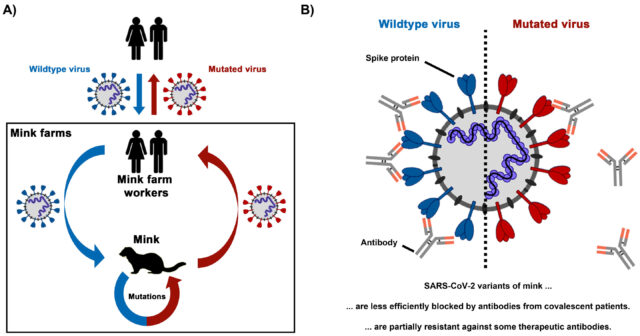It has been known for about a year that minks can become infected with SARS-CoV-2. The virus had been transmitted from humans to farmed mink and mutated in infected animals. Mutations were acquired in the spike protein, which is crucial for the entry of the virus into host cells and represents the central point of attack for antibodies. These SARS-CoV-2 variants from mink were transmitted back to humans, raising concerns that minks could be a continuing source of infection of humans with SARS-CoV-2 variants with altered biological properties.
Researchers at the German Primate Center (DPZ) — Leibniz Institute for Primate Research in Göttingen, Germany, have now shown that an antibody used for COVID-19 therapy is unable to effectively inhibit SARS-CoV-2 harboring a spike mutation acquired in minks. In addition, the mutation reduced the inhibition of the virus by antibodies produced in SARS-CoV-2 infected humans. These results show that SARS-CoV-2 can acquire mutations in minks that may reduce control of the virus by the human immune system (Cell Reports).
More than three million people have died worldwide from the pandemic spread of SARS coronavirus-2 and its associated disease COVID-19, according to the World Health Organization (WHO). Animal-to-human transmission of the virus is believed to be the origin of the pandemic, which began in Wuhan, China, in December 2019. In April 2020, mink in Dutch mink farms developed a respiratory disease due to infection with SARS-CoV-2, which was transmitted from infected farm workers to the animals. The virus mutated in mink and different virus variants emerged, which were transmitted back to farm workers and then also transmitted from human to human. This observation was also made in Denmark and millions of minks were killed to prevent the transmission of new viral variants to humans.
The spike protein in the envelope of SARS-CoV-2 is responsible for the entry of the virus into cells in which it replicates. Researchers led by Markus Hoffmann and Stefan Pöhlmann of the German Primate Center have studied mutations detected in the spike protein of SARS-CoV-2 from mink, including mutation Y453F. The researchers wanted to find out whether this mutation affects inhibition of the virus by antibodies that are used for COVID-19 therapy or are produced in COVID-19 patients.
“Our results show that one of two antibodies from an antibody cocktail used for COVID-19 therapy no longer efficiently inhibits the viral variant with the Y453F mutation. Furthermore, our study demonstrates that the Y453F mutation reduces inhibition of the virus by antibodies produced by COVID-19 patients. This means that people who were infected with SARS-CoV-2 may have reduced protection against mink variants of the virus,” says Markus Hoffmann, first author of the study. In sum, SARS-CoV-2 can mutate in minks in a way that reduces immune control by antibodies. Whether this is also possible in other animals to which the virus can be transmitted by infected individuals is currently unclear. “In the meantime, the Y453F mutation has also occurred in humans, but not through infection with a mink variant. When the virus replicates for a long time in people who are immunocompromised, resistant variants can emerge. In this case, the resistance-mediating mutation was identical to the one observed in mink,” says Stefan Pöhlmann.
Find your dream job in the space industry. Check our Space Job Board »
Provided by: The German Primate Center
More information: Markus Hoffmann et al. SARS-CoV-2 mutations acquired in mink reduce antibody-mediated neutralization. Cell Reports (2021). DOI: 10.1016/j.celrep.2021.109017
Image: Introduction of SARS-CoV-2 into farmed mink leads to the emergence of viral variants that partially evade antibody-mediated neutralization. A) SARS-CoV-2-infected workers introduced the virus into farmed mink populations, causing an epidemic spread of the virus in the animals. As a result, the virus mutated in mink and gave rise to a novel SARS-CoV-2 variant. This novel variant was subsequently transmitted back to workers, sparking transmission chains in the local community. B) SARS-CoV-2 from mink harbor one or more mutations in the viral spike protein, which is used by the virus to enter cells and constitutes the main target for neutralizing antibodies. These mutations enable the virus to partially evade from neutralization by antibodies from convalescent individuals and synthetic antibodies used for COVID-9 therapy.
Credit: Markus Hoffmann











